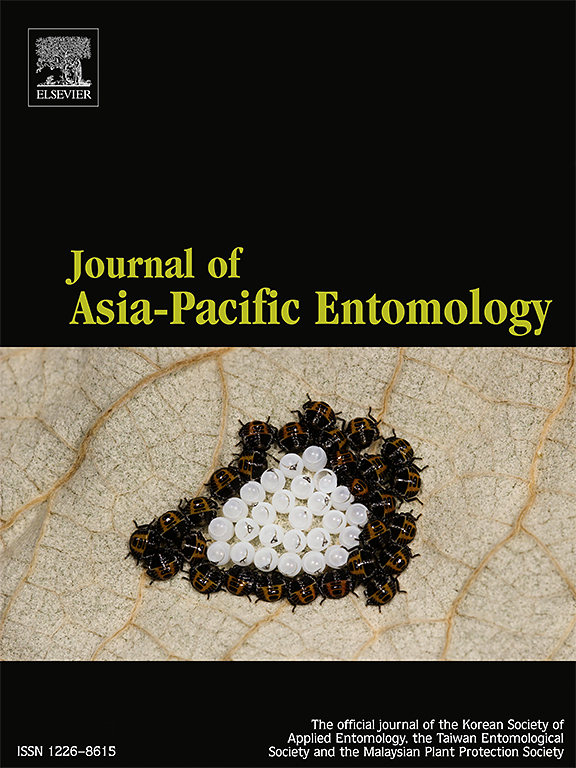Untargeted metabolomics of Spodoptera litura (Lepidoptera: Noctuidae) gut reveals physiological difference among eight diets
IF 1.3
3区 农林科学
Q3 ENTOMOLOGY
引用次数: 0
Abstract
Spodoptera litura (Fabricius) is a major pest of tobacco and other hosts. Mass-rearing of S. litura is essential for implementing various control strategies. We evaluated the effects of eight different diets on the growth and development of S. litura larvae, followed by untargeted metabolomics analysis to assess physiological and metabolic differences in their gut due to diet variations. Significant differences were observed in the development duration and weight of S. litura larvae across different diets. When reaching the fourth instar, larvae fed with corn leaf powder (development periods: 2.13 ± 0.12 days; weights: 4.68 ± 0.09 g) and Chenopodium album leaf powder (2.05 ± 0.10 days; 4.69 ± 0.09 g) had shorter development periods and greater weights compared to those fed with tobacco (2.56 ± 0.10 days; 4.52 ± 0.12 g), C. album (2.49 ± 0.12 days; 4.53 ± 0.11 g), and other groups. Moreover, metabolites from natural diets negatively impacted larval growth, with the lower quantities and expression levels in significantly enriched pathways than those in corn leaf powder and C. album leaf powder. Among the natural diets, C. album outperformed both tobacco and corn. Artificial diet with corn leaf powder is suitable for mass-rearing of S. litura. This study serves as a reference for optimizing the artificial diet of S. litura.

斜夜蛾(鳞翅目:夜蛾科)肠道的非靶向代谢组学揭示了8种饮食的生理差异
斜纹夜蛾(Spodoptera litura)是烟草和其他寄主的主要害虫。大规模饲养斜纹夜蛾是实施各种防治策略的必要条件。我们评估了8种不同饮食对斜纹夜蛾幼虫生长发育的影响,随后进行了非靶向代谢组学分析,以评估饮食变化对其肠道生理和代谢的影响。不同日粮对斜纹夜蛾幼虫的发育期和体重有显著影响。4龄时,以玉米叶粉为食的幼虫(发育周期:2.13±0.12 d;重量:4.68±0.09 g)和藜叶粉(2.05±0.10 d);(4.69±0.09 g)与烟叶组(2.56±0.10 d)相比,生育期短,体重大;4.52±0.12 g), C. album(2.49±0.12 d);4.53±0.11 g),其他各组。此外,天然日粮代谢物对幼虫生长有负面影响,在显著富集的途径中,代谢物的数量和表达水平低于玉米叶粉和天牛叶粉。在天然日粮中,黄芪的表现优于烟草和玉米。玉米叶粉人工饲料适合斜纹夜蛾的批量饲养。本研究可为斜纹锦鲤人工饲料的优化提供参考。
本文章由计算机程序翻译,如有差异,请以英文原文为准。
求助全文
约1分钟内获得全文
求助全文
来源期刊

Journal of Asia-pacific Entomology
Agricultural and Biological Sciences-Insect Science
CiteScore
2.70
自引率
6.70%
发文量
152
审稿时长
69 days
期刊介绍:
The journal publishes original research papers, review articles and short communications in the basic and applied area concerning insects, mites or other arthropods and nematodes of economic importance in agriculture, forestry, industry, human and animal health, and natural resource and environment management, and is the official journal of the Korean Society of Applied Entomology and the Taiwan Entomological Society.
 求助内容:
求助内容: 应助结果提醒方式:
应助结果提醒方式:


